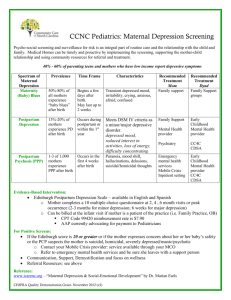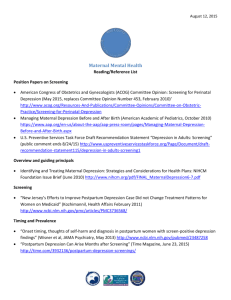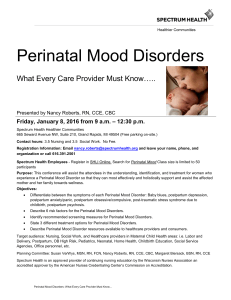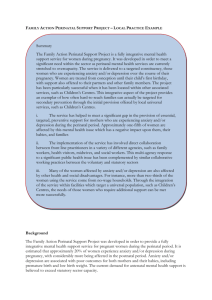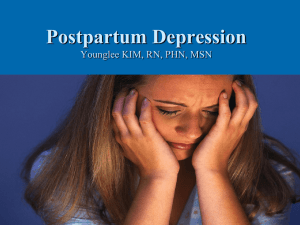Perinatal Mood & Anxiety Disorders - University of California, San
advertisement
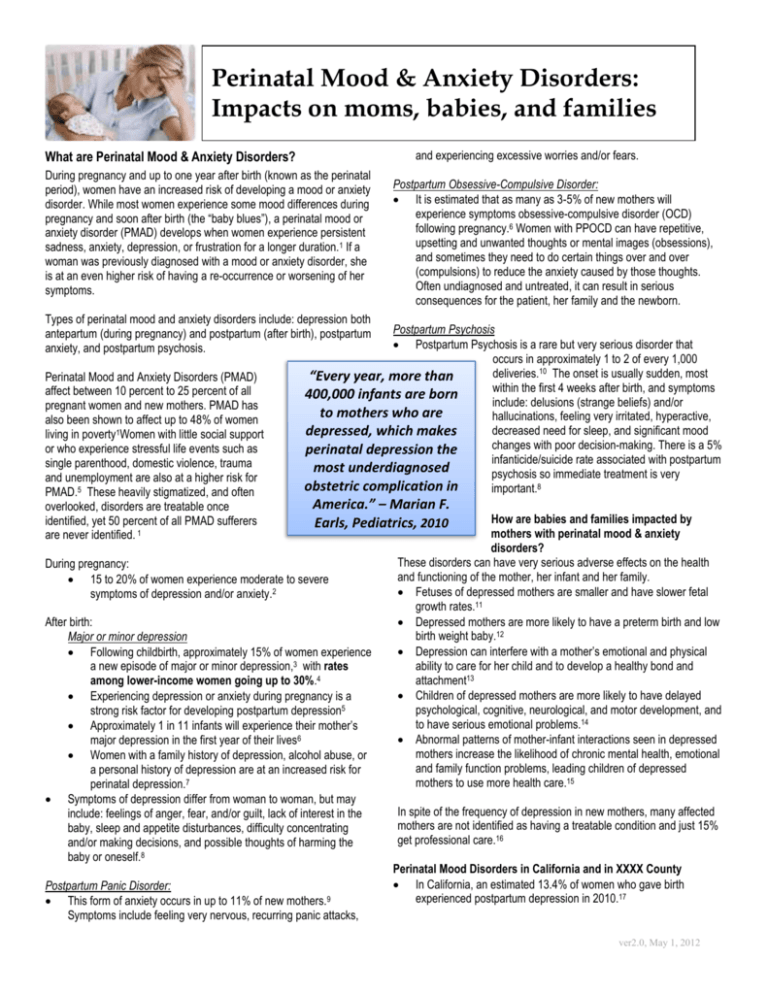
Perinatal Mood & Anxiety Disorders: Impacts on moms, babies, and families and experiencing excessive worries and/or fears. What are Perinatal Mood & Anxiety Disorders? During pregnancy and up to one year after birth (known as the perinatal period), women have an increased risk of developing a mood or anxiety disorder. While most women experience some mood differences during pregnancy and soon after birth (the “baby blues”), a perinatal mood or anxiety disorder (PMAD) develops when women experience persistent sadness, anxiety, depression, or frustration for a longer duration.1 If a woman was previously diagnosed with a mood or anxiety disorder, she is at an even higher risk of having a re-occurrence or worsening of her symptoms. Postpartum Obsessive-Compulsive Disorder: It is estimated that as many as 3-5% of new mothers will experience symptoms obsessive-compulsive disorder (OCD) following pregnancy.6 Women with PPOCD can have repetitive, upsetting and unwanted thoughts or mental images (obsessions), and sometimes they need to do certain things over and over (compulsions) to reduce the anxiety caused by those thoughts. Often undiagnosed and untreated, it can result in serious consequences for the patient, her family and the newborn. Types of perinatal mood and anxiety disorders include: depression both antepartum (during pregnancy) and postpartum (after birth), postpartum anxiety, and postpartum psychosis. Perinatal Mood and Anxiety Disorders (PMAD) affect between 10 percent to 25 percent of all pregnant women and new mothers. PMAD has also been shown to affect up to 48% of women living in poverty1Women with little social support or who experience stressful life events such as single parenthood, domestic violence, trauma and unemployment are also at a higher risk for PMAD.5 These heavily stigmatized, and often overlooked, disorders are treatable once identified, yet 50 percent of all PMAD sufferers are never identified. 1 Postpartum Psychosis Postpartum Psychosis is a rare but very serious disorder that occurs in approximately 1 to 2 of every 1,000 deliveries.10 The onset is usually sudden, most “Every year, more than within the first 4 weeks after birth, and symptoms 400,000 infants are born include: delusions (strange beliefs) and/or to mothers who are hallucinations, feeling very irritated, hyperactive, decreased need for sleep, and significant mood depressed, which makes changes with poor decision-making. There is a 5% perinatal depression the infanticide/suicide rate associated with postpartum most underdiagnosed psychosis so immediate treatment is very obstetric complication in important.8 America.” – Marian F. Earls, Pediatrics, 2010 During pregnancy: 15 to 20% of women experience moderate to severe symptoms of depression and/or anxiety.2 After birth: Major or minor depression Following childbirth, approximately 15% of women experience a new episode of major or minor depression,3 with rates among lower-income women going up to 30%.4 Experiencing depression or anxiety during pregnancy is a strong risk factor for developing postpartum depression5 Approximately 1 in 11 infants will experience their mother’s major depression in the first year of their lives6 Women with a family history of depression, alcohol abuse, or a personal history of depression are at an increased risk for perinatal depression.7 Symptoms of depression differ from woman to woman, but may include: feelings of anger, fear, and/or guilt, lack of interest in the baby, sleep and appetite disturbances, difficulty concentrating and/or making decisions, and possible thoughts of harming the baby or oneself.8 Postpartum Panic Disorder: This form of anxiety occurs in up to 11% of new mothers.9 Symptoms include feeling very nervous, recurring panic attacks, How are babies and families impacted by mothers with perinatal mood & anxiety disorders? These disorders can have very serious adverse effects on the health and functioning of the mother, her infant and her family. Fetuses of depressed mothers are smaller and have slower fetal growth rates.11 Depressed mothers are more likely to have a preterm birth and low birth weight baby.12 Depression can interfere with a mother’s emotional and physical ability to care for her child and to develop a healthy bond and attachment13 Children of depressed mothers are more likely to have delayed psychological, cognitive, neurological, and motor development, and to have serious emotional problems.14 Abnormal patterns of mother-infant interactions seen in depressed mothers increase the likelihood of chronic mental health, emotional and family function problems, leading children of depressed mothers to use more health care.15 In spite of the frequency of depression in new mothers, many affected mothers are not identified as having a treatable condition and just 15% get professional care.16 Perinatal Mood Disorders in California and in XXXX County In California, an estimated 13.4% of women who gave birth experienced postpartum depression in 2010.17 ver2.0, May 1, 2012 The Economic Impact of Perinatal Mood and Anxiety Disorders A recent study found that depressed women had 90% higher health services expenditures than nondepressed women.18 Depression among workers in general cost U.S. employers $44 billion per year in lost productivity and about $12.4 billion in health care expenditures. With 56% of mother of infants in 2010 participating in the labor force, there is a significant impact of postpartum depression on the use and costs of healthcare services among employed women. What is California and XXXX County doing to help (or screen, diagnose and treat) women with perinatal mood & anxiety disorders? MCAH promotes provider screening, education, and referral to treatment and services for women and youth at risk of depression, anxiety, substance use, and domestic violence and encourages providers to incorporate mental health and behavioral issues into program activities. Due to the importance of early identification and treatment of depression, several MCAH programs incorporate the following activities: The California Home Visiting Program (CHVP) and Black Infant Health (BIH) program utilize the Edinburgh Postnatal Depression Scale (EPDS) to identify and refer women for appropriate treatment. The Adolescent Family Life Program (AFLP) also promotes the identification of depression in youth in the assessment process and will be recommending specific screening tools for youth. The Comprehensive Perinatal Services Program (CPSP) provides education on emotional and mental health. MCAH continues to work to maintain and improve appropriate linkages between other State departments to address systemic barriers and create pathways to service delivery. The Bottom Line PMAD affects a large number of families and can adversely affect parenting and health child development, yet too few women receive screening and even fewer receive treatment. As today’s children become the next generation of parents and workers, expanded efforts are needed to screen and treat women to reduce the harmful effects of maternal depression on children’s developing brains. REFERENCES 1 PMAD Project. California State Library, California Research Bureau Services. http://www.library.ca.gov/crb/pmad/ 2 Bennett, H.A., Einarson, A., Taddio, A., Koren, G., & Einarson, T.R. (2004). Prevalence of depression during pregnancy: a systematic review. Obstetric Gynecology, 103(4), 698-709. 3 Marcus, S. (2009). Depression during pregnancy: rates, risks, and consequences. Canadian Journal of Clinical Pharmacology, 150, 662-673. 4 Boyd, R.C., Zayas, L.H., & McKee, M.D. (2006). Mother-infant interaction, life events, and prenatal and postpartum depressive symptoms among urban minority women in primary care. Maternal and Child Health Journal, 10(2). 139-148. 5 Robertson, E., Grace, S., Wallington, T., & Stewart, D.E. (2004). Antenatal risk factors for postpartum depression: a synthesis of recent literature. General Hospital Psychiatry, 26, 289-295. 6 Center on the Developing Child at Harvard University (2009). Maternal Depression Can Undermine the Development of Young Children: Working Paper No. 8. http://www.developingchild.harvard.edu 7 Kahn, R.S., Wise, P.H., Wilson, K., (2002) Maternal smoking, drinking and depression: a generational link between socioeconomic status and child behavior problems].Pediatric Res.;51(pt2):191A. 8 Postpartum Support International (2009). Perinatal mood and anxiety disorders: Fact sheet. Retrieved from http://www.postpartum.net/Get-the-Facts.aspx and http://www.postpartum.net/Get-the-Facts/Postpartum-Psychosis.aspx 9 Wisner, K.L., Peindl, K.S., & Hanusa, B.H. (1996). Effects of childbearing on the natural history of panic disorder with comorbind mood disorder. Journal of Affective Disorders, 41, 173-180. 10 Sit, D., et al ., A review of postpartum psychosis, Journal of Women’s Health, 2006 May:15(4):352-68. 11 Field, T. (2010). Prenatal depression effects on early development: A review Infant Behav Dev. 2010 December; 33(4): 409–418. 12 Grote, N.K., Bridge, J.A., Gavin, A.R., Melville, J.L., Iyengar, S., & Katon, W.J. (2010). A meta-analysis of depression during pregnancy and the risk of preterm birth, low birth weight, and intrauterine growth restriction. Archives of General Psychiatry, 67(10), 1012-1024. 13 Earls MF & the Committee on Psychosocial Aspects of Child and Family Health. Clinical report incorporating recognition and management of perinatal and postpartum depression into pediatric practice. Pediatrics. 2010;126:5; 1032-1039. 14 Weissman MM, Feder A, Pilowsky DJ, et al. Depressed mothers coming to primary care: maternal reports of problems with their children. J Aff Disorders. 2004; 78: 93-100. 15 T, Buzwell S. Romeo Y, Bowland J. Avoidant attachment as a risk factor for health. Br J Med Psych. 1994; 67: 237-45 16 Vegas-Lopex, Ol, Blanco, C., Keyes, K., Olfson, M., Grant, B., & Hasin, D. (2008). Psychiatric disorders in pregnant and postpartum women in the United States. Archives of General Psychiatry, 65, 805-815. 17 Maternal and Infant Health Assessment Survey. Maternal, Child and Adolescent Health Program, Center for Family Health, California Department of Public Health. 2010. 18 Dagher RK, McGovern PM, Dowd BE, Gjerdingen DK.J Postpartum depression and health services expenditures among employed women. Occup Environ Med. 2012 Feb;54(2):210-5 Prepared by the Family Health Outcomes Project, University of California, San Francisco and the California Department of Public Health, MCAH Program, with assistance by California MCAH Action. Visit FHOP at http://fhop.ucsf.edu/ and CDPH MCAH Program at http://tiny.cc/02io6 ver2.0, May 1, 2012
